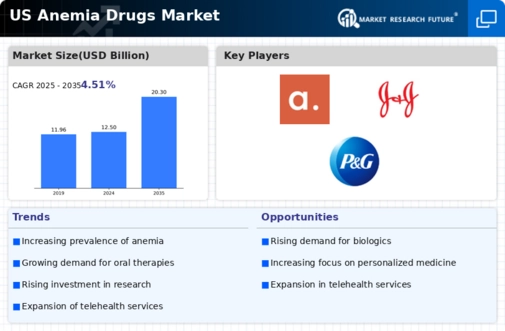Aging Population
The aging population in the US is a significant factor influencing the anemia drugs market. As individuals age, the risk of developing anemia increases due to various factors such as chronic diseases, nutritional deficiencies, and decreased bone marrow function. According to the US Census Bureau, the population aged 65 and older is projected to reach 80 million by 2040, which may lead to a higher incidence of anemia. This demographic shift suggests a growing need for effective anemia treatments, thereby driving the market for anemia drugs. Pharmaceutical companies are likely to focus on developing targeted therapies to cater to this aging demographic.
Rising Healthcare Expenditure
The increase in healthcare expenditure in the US is another driver for the anemia drugs market. With healthcare spending projected to reach $6 trillion by 2027, there is a growing investment in innovative treatments and therapies for various health conditions, including anemia. This financial commitment from both public and private sectors is likely to enhance research and development efforts, leading to the introduction of new anemia drugs. Furthermore, as patients gain better access to healthcare services, the likelihood of receiving timely diagnosis and treatment for anemia increases, further propelling the market.
Focus on Personalized Medicine
The trend towards personalized medicine is emerging as a significant driver in the anemia drugs market. Tailoring treatments to individual patient profiles, including genetic makeup and specific health conditions, is becoming increasingly feasible. This approach may lead to more effective anemia therapies, as treatments can be customized to address the unique needs of patients. As healthcare providers adopt personalized medicine strategies, the demand for specialized anemia drugs is likely to rise. This shift could also encourage pharmaceutical companies to invest in research and development of targeted therapies, further stimulating the anemia drugs market.
Increasing Awareness of Anemia
The growing awareness of anemia among healthcare professionals and patients is a crucial driver for the anemia drugs market. Educational initiatives and campaigns by health organizations have highlighted the symptoms and risks associated with anemia, leading to increased diagnosis rates. As a result, more individuals are seeking treatment options, which is likely to boost demand for anemia drugs. In the US, the prevalence of anemia is estimated to affect approximately 3 million individuals, with iron deficiency being the most common cause. This heightened awareness is expected to contribute to a more proactive approach in managing anemia, thereby expanding the market for anemia drugs.
Advancements in Diagnostic Techniques
Advancements in diagnostic techniques are playing a pivotal role in the anemia drugs market. Improved screening methods, such as high-throughput blood tests and genetic testing, enable healthcare providers to diagnose anemia more accurately and efficiently. This enhanced diagnostic capability is likely to lead to earlier detection and treatment of anemia, which could increase the demand for anemia drugs. The integration of technology in diagnostics not only streamlines the process but also raises awareness about the condition, potentially expanding the patient base for anemia treatments.

















Leave a Comment